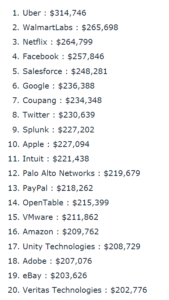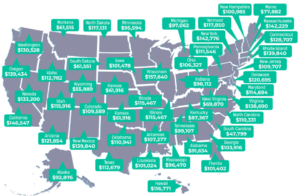
Why Data Scientists Love the Law of Supply and Demand

It should come as no surprise that demand for data scientists keeps going up. However, supply of data scientists has not kept pace, unfortunately (or fortunately, depending on your point of view). Thanks to the law of supply and demand, companies are being asked to pay annual salaries well into the six figures – and sometimes even seven or eight figures – to attract and retain top AI talent.
In February, Element released an analysis of LinkedIn profiles that concluded there are only about 22,000 Ph.D.-carrying data science researchers and engineers worldwide who have the technical skills to deploy deep learning methodologies in a commercial setting. What’s more, only about 3,000 of those data scientists are currently looking for a job – although it’s common for companies to poach top data talent from competitors.
The United States serves as a global hub for AI and data science talent, according to Element, which is an AI research firm based in Montreal, Quebec. The company cited research from Paysa that found there were 10,000 job openings for AI positions in the United States last year,. That means for every AI job hunter, there are more than three AI job openings.
Is it any wonder, then, that data scientist salaries keep going up?
Playing with the Big Boys
Paysa estimated last year that that companies in the United States paid $1.35 billion to attract and retain AI talent. However, according to its calculations, the 10 biggest tech firms spent accounted for nearly $700 million of that total.
If you’re in the market for a data scientist or AI expert, you’re competing against the likes of Amazon, Microsoft, Google, and Apple, which have the deep pockets to spend salaries of $300,000 to $500,000 per year, which is what the New York Times last year reported was the average spread for AI specialist.
This run on AI experts is perhaps most evident in the self-driving car field, where deep learning technology and techniques are being applied by every firm in the race. General Motors spent almost $1 billion to acquire a firm with the needed talent, while Uber spent nearly $700 million. According to the NYT story, Google paid its top self-driving car employee more than $120 million before he left for Uber (which is the subject of a lawsuit).
It might be easier to find (and keep) a data scientist who is not involved in handcoding and tuning convolutional neural networks. According to a recent survey from Springboard, the average salary for a data scientist in the United States was about $113,000. However, there was considerable spread in the salaries, with firms in California paying their data scientists about $146,000 per year, while data scientists in Kansas and South Dakota are paid about $62,000.
The pay for other data-oriented jobs is also good. Springboard found that the average data engineer’s salary is about $90,000, while data analysts can expect to bring home $74,000 per year (before taxes, of course). All told, the number of data-related job openings is expected to surpass 2.7 million by 2020, according to a figure from IBM.
Supply Side Responds
The huge demand for AI experts, data scientists, data engineers, and data analysts is not expected to abate any time soon, which will likely keep salaries for these positions growing for the time being.
In response to these forces, the market is responding by ramping up production, which largely occurs through colleges, universities, and other educational venues. This fall, the University of California, Berkeley announced that 780 students have declared for the new Data Science major at the school.
Other institutions are making moves to educate more data scientists. One of those is edX, the non-profit online organization founded by Harvard and MIT, which this month launched a new Masters Degree program. The program has been implemented at several universities, including Georgia Institute of Technology and its Master of Science in Analytics, and the University of California, San Diego and its new Master of Data Science. It also launched the Data Science Professional Certificate at UC Berkeley earlier this year in cooperation with Google, Microsoft, and Cloudera.
These are good times to be a data scientist or an AI expert, to be sure. And thanks to all the attention (and high salaries) that these professionals are getting, a new class of data scientists is being trained to satisfy the unmet demand that the big data explosion has unleashed on the world.
Related Items:
Improving Your Odds with Data Science Hiring
Engineers Vs. Scientists: Who to Hire in Data Now?
































